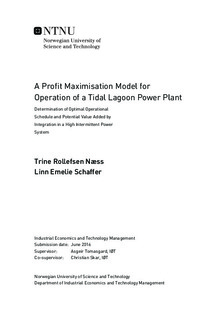A Profit Maximisation Model for Operation of a Tidal Lagoon Power Plant - Determination of Optimal Operational Schedule and Potential Value Added by Integration in a High Intermittent Power System
Master thesis
Permanent lenke
http://hdl.handle.net/11250/2433830Utgivelsesdato
2016Metadata
Vis full innførselSamlinger
Sammendrag
A stochastic profit maximisation model for operation of a tidal lagoon power plant including production head effects, power market prices and start-up costs is developed. The model is formulated as a two-stage stochastic mixed integer programming problem with bidding decisions in the first stage, and plant operation and real-time sales in the second stage. The Swansea Bay Tidal Lagoon project is taken as case study and the analysis is performed including sales in the United Kingdom (UK) day-ahead (spot) and intraday market for different power price characteristics. The largest annual energy production is estimated to 317 GWh and operational income is estimated to 15 million Great British Pounds (GBP) for current price characteristics. Two optimal power generation schedules based on different power price characteristics are identified and the value of short-term flexibility is estimated. A tidal lagoon power plant is shown to benefit from limited short-term operational flexibility and the value of flexibility is seen to increase with power price variance.
Further, the European power system model EMPIRE is extended to include tidal lagoon power resources. The extension comprise some flexibility in operational decisions by introducing a set of optional production schedules based on the findings in the above mentioned operational model. A tidal lagoon portfolio along the coast of Great Britain is used for a case study analysing the impact of developing and deploying tidal lagoon generation capacity in Great Britain. It is shown that the cost of energy from tidal lagoon power generators is high compared to other technologies. Only small emission reductions are accomplished by investing in tidal lagoon generators in Great Britain.
